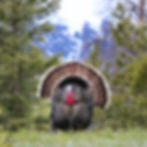All About Merriam's Turkeys
- Good Bull Guided
- May 10, 2023
- 2 min read

Merriam's turkeys are one of five subspecies of wild turkey found in the United States and Mexico. They are named after the biologist C. Hart Merriam, who first described this subspecies in 1900. Merriam's turkeys are unique in their appearance, behavior, and habitat. In this blog post, we'll explore their lifecycle, breeding, feeding habits, and much more!
Merriam's Turkeys are a medium-sized bird with males weighing up to 20+ pounds and females weighing between 8-12 pounds. They have distinctive plumage with metallic green and bronze iridescence on their feathers and (unique to Merriam’s) bright white-tipped tail feathers. The males, or toms (juvenile males are called jakes), have a bright head that can include colors of red, white and blue depending on their mood. Males also have a beard (rope-like tuft of hair) that protrudes from their chest, spurs on their lower legs for fighting, and a snood (a small piece of skin and hair usually several inches long that hangs over their beak). Females, or hens, have a duller coloration and typically lack the beard and spurs (and have a smaller snood) though bearded hens are somewhat common.
Merriam’s turkeys inhabit the western mountain and foothill regions of the United States including ponderosa pine forests, oak woodlands, and mountain meadows. They prefer areas with a mix of open space for foraging and dense cover for protection. In the summer months, they can be found at higher elevations while in the winter they move to lower elevations to avoid heavy snow. In Rocky Mountain National Park turkeys can be found up to 9,000 feet in elevation during late spring and summer and they migrate out of the park for winter.
Merriam's are a social bird, often found in flocks of 5 to 30 birds but occasionally in groups much larger – especially in winter. They roost in trees at night and spend their days foraging for food on the ground. Their diet consists of seeds, insects, berries, grasses, and small animals. During the breeding season, males display a behavior known as "strutting," where they fan out their tail feathers, puff out their chests, and drag their wings on the ground to attract females. The sound of their gobbling can be heard from far away and is a common sound in the forests and meadows where they live each spring. Interestingly, turkeys can shock gobble – reacting to loud or unusual sounds like a car door closing by gobbling and other turkey’s gobbling will often cause all the turkeys in a group to gobble! Other turkey vocalizations include purrs, putts, clucks, cackles and yelps.
Merriam's turkeys are one of several subspecies of wild turkey found in North America. Other subspecies include Eastern, Osceola, Rio Grande, and Gould's turkeys. While all subspecies have similar lifecycles and behaviors, they differ in their appearance and habitat. For example, Eastern turkeys are found in the eastern United States and have a dark, iridescent plumage while Gould's turkeys are found in northern Mexico and have a pale, almost white plumage.
Join us on a Lower Valley Tour for your chance to see strutting turkeys this Spring. If you won’t be out here until June or later though we might still run into some baby turkeys called poults.
